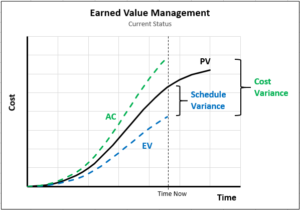 It’s time to determine how far ahead or behind schedule the project is.
It’s time to determine how far ahead or behind schedule the project is.
To do this, we will calculate two variables from the initial four we gathered from the project data:
- Schedule Variance (SV)
- Schedule Performance Index (SPI)
Schedule Variance (SV)
The schedule variance, usually abbreviated SV, answers the question:
- How far ahead or behind schedule is the project?
It is expressed in terms of the task budget, not the actual hours or days ahead or behind schedule. The SV must be calculated for each task and summed to determine the overall project SV.
The formula is:
- If SV is negative, the task is behind schedule.
- If SV is zero, the task is on schedule
- If SV is positive, the task is ahead of schedule.
- SV = -$500 means the project is behind schedule.
- SV = $0 means the project is right on schedule.
- SV = $500 means the project is ahead of schedule.
With the schedule variance, positive is good.
You can compare the size of the schedule variance to the task’s budget. For example, if the above schedule variance of $500 is for a task with a budget of $1,000, the task is significantly behind. But for a task value of $100,000 this is not nearly as concerning.
In our running example, we will add a column to the earned value table for Schedule Variance.
SV = EV – PV
SV = $2,000 – $3,000 = -$1,000.
| ID | Name | Start | End | BAC | PV | EV | AC | SV |
|---|---|---|---|---|---|---|---|---|
| 100 | Set up Database | Mar. 1 | Mar. 10 | $10,000 | $3,000 | $2,000 | $4,500 | -$1,000 |
This task has a schedule variance of -$1,000 on a task value of $10,000, therefore it is 10% behind schedule. It should probably be flagged for action by the project manager, or at least an explanation determined.
Schedule Performance Index (SPI)
The Schedule Performance Index, normally abbreviated SPI, answers the question:
- How efficiently are we using time?
It is similar to the Schedule Variance (SV). It also tells you how far ahead or behind schedule the task is, but it is a relative measure rather than an absolute one. The formula is:
- If SPI is less than 1, the task is behind schedule.
- If SPI is zero, the task is on schedule
- If SPI is greater than 1, the task is ahead of schedule.
For example,
- SPI = 0 means the project work has not started.
- SPI = 0.5 means the project has performed half the work it was supposed to at this point.
- SPI = 1.0 means the project is on schedule.
- SPI = 2.0 means the project has performed twice the work it was supposed to at this point.
With the SPI, greater than 1.0 is good.
We will add a column to the table for SPI.
SPI = EV / PV
SPI = $2,000 / $3,000 = 0.67.
| ID | Name | Start | End | BAC | PV | EV | AC | SV | SPI |
|---|---|---|---|---|---|---|---|---|---|
| 100 | Set up Database | Mar. 1 | Mar. 10 | $10,000 | $3,000 | $2,000 | $4,500 | -$1,000 | 0.67 |
It is easy to see that the example task has accomplished only two thirds of what it should have at this point.
Interpretation
It is well understood that projects which go behind schedule early on will almost always finish behind schedule. The longer the schedule problems persist without major consequences to the project team, the more rooted the behavior will become, creating a culture of missed deadlines that becomes extremely difficult to correct.
For this reason the SV and SPI should be inspected early and often.
In fact, one of the big benefits of earned value management is the ability to get an early warning sign of project issues. A schedule variance of, say, $1,000 on a $50,000 project might be completely unnoticed if you weren’t calculating SV and SPI, but a simple chat with a member of the project team could avoid a major missed deadline later on.
It’s amazing how many projects don’t know their true schedule status until the late stages, when corrections are costly and difficult to make. The correct time to correct schedule problems is at the beginning, not the end, of the project.
In fact it is often not so much the actual schedule variance that matters, but the trend. Graphing SV over multiple status periods is often a very revealing exercise, and gives you a fantastic picture of how the project has been performing.
The two variables SV and SPI give you an at-a-glance look at the project schedule status. On the next page we will do the same for the project’s budget.
Navigation
- Previous Page: Gather Work Performance Information
- Next Page: Determine Cost Status
- Home: Earned Value Tutorial





